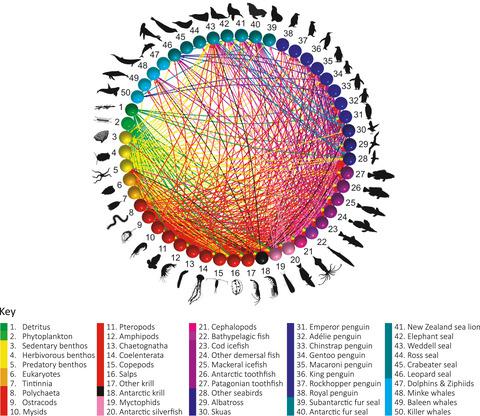当前位置:
X-MOL 学术
›
Ecol. Evol.
›
论文详情
Our official English website, www.x-mol.net, welcomes your feedback! (Note: you will need to create a separate account there.)
Decades of dietary data demonstrate regional food web structures in the Southern Ocean
Ecology and Evolution ( IF 2.6 ) Pub Date : 2020-12-09 , DOI: 10.1002/ece3.7017 Stacey A. McCormack 1 , Jessica Melbourne‐Thomas 2, 3 , Rowan Trebilco 2, 3 , Julia L. Blanchard 1, 3, 4 , Ben Raymond 1, 4, 5 , Andrew Constable 3, 5
Ecology and Evolution ( IF 2.6 ) Pub Date : 2020-12-09 , DOI: 10.1002/ece3.7017 Stacey A. McCormack 1 , Jessica Melbourne‐Thomas 2, 3 , Rowan Trebilco 2, 3 , Julia L. Blanchard 1, 3, 4 , Ben Raymond 1, 4, 5 , Andrew Constable 3, 5
Affiliation

|
Understanding regional‐scale food web structure in the Southern Ocean is critical to informing fisheries management and assessments of climate change impacts on Southern Ocean ecosystems and ecosystem services. Historically, a large component of Southern Ocean ecosystem research has focused on Antarctic krill, which provide a short, highly efficient food chain, linking primary producers to higher trophic levels. Over the last 15 years, the presence of alternative energy pathways has been identified and hypotheses on their relative importance in different regions raised. Using the largest circumpolar dietary database ever compiled, we tested these hypotheses using an empirical circumpolar comparison of food webs across the four major regions/sectors of the Southern Ocean (defined as south of 40°S) within the austral summer period. We used network analyses and generalizations of taxonomic food web structure to confirm that while Antarctic krill are dominant as the mid‐trophic level for the Atlantic and East Pacific food webs (including the Scotia Arc and Western Antarctic Peninsula), mesopelagic fish and other krill species are dominant contributors to predator diets in the Indian and West Pacific regions (East Antarctica and the Ross Sea). We also highlight how tracking data and habitat modeling for mobile top predators in the Southern Ocean show that these species integrate food webs over large regional scales. Our study provides a quantitative assessment, based on field observations, of the degree of regional differentiation in Southern Ocean food webs and the relative importance of alternative energy pathways between regions.
中文翻译:

数十年的饮食数据证明了南大洋的区域食物网结构
了解南大洋的区域规模食物网结构对于告知渔业管理和评估气候变化对南大洋生态系统和生态系统服务的影响至关重要。从历史上看,南大洋生态系统研究的大部分内容都集中在南极磷虾上,后者提供了一条短而高效的食物链,将初级生产者与更高的营养水平联系起来。在过去的15年中,人们已经发现了替代能源途径的存在,并提出了关于替代能源途径在不同地区的相对重要性的假设。使用有史以来最大的绕极饮食数据库,我们使用南方夏季四个主要区域/区域(定义为40°S以南)内食物网的经验绕极比较对这些假设进行了检验。我们使用网络分析和分类学食物网结构的一般化来确认,尽管南极磷虾在大西洋和东太平洋食物网(包括斯科舍弧和南极半岛西部),中生鱼类和其他磷虾种类中居中营养水平是印度和西太平洋地区(南极东部和罗斯海)捕食者饮食的主要贡献者。我们还重点介绍了对南大洋移动捕食者的跟踪数据和栖息地建模如何显示这些物种在较大区域范围内整合了食物网。我们的研究基于实地观察,对南部海洋食物网的区域分化程度以及区域之间替代性能源途径的相对重要性提供了定量评估。
更新日期:2021-01-08
中文翻译:

数十年的饮食数据证明了南大洋的区域食物网结构
了解南大洋的区域规模食物网结构对于告知渔业管理和评估气候变化对南大洋生态系统和生态系统服务的影响至关重要。从历史上看,南大洋生态系统研究的大部分内容都集中在南极磷虾上,后者提供了一条短而高效的食物链,将初级生产者与更高的营养水平联系起来。在过去的15年中,人们已经发现了替代能源途径的存在,并提出了关于替代能源途径在不同地区的相对重要性的假设。使用有史以来最大的绕极饮食数据库,我们使用南方夏季四个主要区域/区域(定义为40°S以南)内食物网的经验绕极比较对这些假设进行了检验。我们使用网络分析和分类学食物网结构的一般化来确认,尽管南极磷虾在大西洋和东太平洋食物网(包括斯科舍弧和南极半岛西部),中生鱼类和其他磷虾种类中居中营养水平是印度和西太平洋地区(南极东部和罗斯海)捕食者饮食的主要贡献者。我们还重点介绍了对南大洋移动捕食者的跟踪数据和栖息地建模如何显示这些物种在较大区域范围内整合了食物网。我们的研究基于实地观察,对南部海洋食物网的区域分化程度以及区域之间替代性能源途径的相对重要性提供了定量评估。



























 京公网安备 11010802027423号
京公网安备 11010802027423号